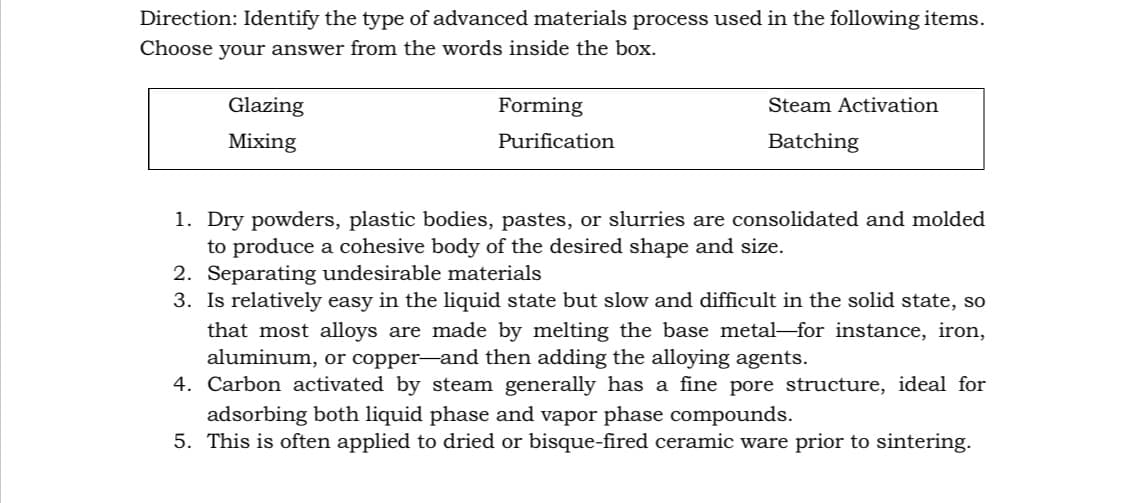4. Carbon activated by steam generally has a fine pore structure, ideal for adsorbing both liquid phase and vapor phase compounds. 5. This is often applied to dried or bisque-fired ceramic ware prior to sintering.
4. Carbon activated by steam generally has a fine pore structure, ideal for adsorbing both liquid phase and vapor phase compounds. 5. This is often applied to dried or bisque-fired ceramic ware prior to sintering.
Chemistry & Chemical Reactivity
9th Edition
ISBN:9781133949640
Author:John C. Kotz, Paul M. Treichel, John Townsend, David Treichel
Publisher:John C. Kotz, Paul M. Treichel, John Townsend, David Treichel
Chapter4: Stoichiometry: Quantitative Information About Chemical Reactions
Section: Chapter Questions
Problem 102GQ: Cloth can be waterproofed by coating it with a silicone layer. This is done by exposing the cloth to...
Related questions
Question
Subpart 4-5

Transcribed Image Text:Direction: Identify the type of advanced materials process used in the following items.
Choose your answer from the words inside the box.
Glazing
Forming
Steam Activation
Mixing
Purification
Batching
1. Dry powders, plastic bodies, pastes, or slurries are consolidated and molded
to produce a cohesive body of the desired shape and size.
2. Separating undesirable materials
3. Is relatively easy in the liquid state but slow and difficult in the solid state, so
that most alloys are made by melting the base metal-for instance, iron,
aluminum, or copper-and then adding the alloying agents.
4. Carbon activated by steam generally has a fine pore structure, ideal for
adsorbing both liquid phase and vapor phase compounds.
5. This is often applied to dried or bisque-fired ceramic ware prior to sintering.
Expert Solution
This question has been solved!
Explore an expertly crafted, step-by-step solution for a thorough understanding of key concepts.
Step by step
Solved in 2 steps with 2 images

Knowledge Booster
Learn more about
Need a deep-dive on the concept behind this application? Look no further. Learn more about this topic, chemistry and related others by exploring similar questions and additional content below.Recommended textbooks for you

Chemistry & Chemical Reactivity
Chemistry
ISBN:
9781133949640
Author:
John C. Kotz, Paul M. Treichel, John Townsend, David Treichel
Publisher:
Cengage Learning

Chemistry & Chemical Reactivity
Chemistry
ISBN:
9781337399074
Author:
John C. Kotz, Paul M. Treichel, John Townsend, David Treichel
Publisher:
Cengage Learning

Chemical Principles in the Laboratory
Chemistry
ISBN:
9781305264434
Author:
Emil Slowinski, Wayne C. Wolsey, Robert Rossi
Publisher:
Brooks Cole

Chemistry & Chemical Reactivity
Chemistry
ISBN:
9781133949640
Author:
John C. Kotz, Paul M. Treichel, John Townsend, David Treichel
Publisher:
Cengage Learning

Chemistry & Chemical Reactivity
Chemistry
ISBN:
9781337399074
Author:
John C. Kotz, Paul M. Treichel, John Townsend, David Treichel
Publisher:
Cengage Learning

Chemical Principles in the Laboratory
Chemistry
ISBN:
9781305264434
Author:
Emil Slowinski, Wayne C. Wolsey, Robert Rossi
Publisher:
Brooks Cole

Chemistry for Engineering Students
Chemistry
ISBN:
9781285199023
Author:
Lawrence S. Brown, Tom Holme
Publisher:
Cengage Learning